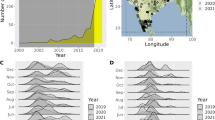Abstract
The Blackcap Sylvia atricapilla is a model species for the evolution of bird migration in a time of global change. However, many assumptions about putative changes to their migratory paths have not been verified because, until recently, it has not been possible to track individual small passerines throughout the entire migration cycle. With the recent development of miniaturised light-level geolocators, it is now possible to track passerines throughout the migration cycle and test these latter assumptions. We deployed 100 geolocators on Blackcaps breeding in southern Germany in 2015, and recaptured three of these birds in 2016. We used a new analytical tool implemented in the R package GeoLight to identify stopover sites during migration. One bird migrated due west to winter in southern England or possibly northwestern France, whereas two birds migrated south towards North Africa via Italy. Although none of the retrieved geolocators collected data throughout the entire migration cycle, the data suggest that migration patterns of the species are more complex than previously thought.
Zusammenfassung
Erste Verfolgungen individueller Zugwege von Mönchsgrasmücken lassen ein komplexes Migrationsverhalten annehmen
Die Mönchsgrasmücke Sylvia atricapilla ist eine Modellart zur Erforschung der Evolution des Vogelzugs in Zeiten des globalen Wandels. Viele Annahmen zur vermuteten Verlagerung von Zugwegen konnten aber bisher nicht getestet werden, da es bisher nicht möglich war, individuelles Zugverhalten während eines Zugzyklus zu erfassen. Mit der Entwicklung miniaturisierter Lichtlogger ist dies nun möglich. Wir statteten 2015 einhundert in Süddeutschland brütende Mönchsgrasmücken mit Lichtloggern aus, von denen wir drei 2016 wieder fingen. Wir wendeten eine neue analytische Methode im R-Paket GeoLight an, um Ratsplätze auf dem Zug zu identifizieren. Eine Mönchsgrasmücke zog nach Westen, um in Südengland oder möglicherweise auch in Nordfrankreich zu überwintern. Zwei weitere Vögel zogen über Italien nach Nordafrika. Obwohl keiner der Logger über den gesamten Zugzyklus Daten erfasste, zeigen die Ergebnisse, dass der Zug der Mönchgrasmücke komplexer sein könnte als bisher angenommen.


Similar content being viewed by others
References
Bairlein F (1978) Über die Biologie einer südwestdeutschen Population der Mönchsgrasmücke. J Ornithol 119:14–51
Bairlein F, Dierschke J, Dierschke V, Salewski V, Geiter O, Hüppop K, Köppen U, Fiedler W (2014) Atlas des Vogelzugs—Ringfunde deutscher Brut- und Gastvögel. AULA, Wiebelsheim
Bearhop S, Fiedler W, Furness RW, Voitier SC, Waldron S, Newton J, Bowen GJ, Berthold P, Farnsworth K (2005) Assortative mating as a mechanism for rapid evolution of a migratory divide. Science 310:502–504
Berthold P (1995) Microevolution of migratory behaviour illustrated by the Blackcap Sylvia atricapilla: 1993 Witherby Lecture. Bird Study 42:89–100
Berthold P, Helbig AJ, Mohr G, Querner U (1992) Rapid microevolution of migratory behaviour in a wild bird species. Nature 360:668–670
Bridge ES, Thorup K, Bowlin MS, Chilson PB, Diehl RH, Fléron RW, Hartl P, Kays R, Kelly JF, Robinson WD, Wikelski M (2011) Technology on the move: recent and forthcoming innovations for tracking migratory birds. Bioscience 61:689–698
Campbell NA, Reece JB, Urry LA, Cain ML, Wasserman SA, Minorsky PV, Jackson RB (2008) Biology. Benjamin Cummings, San Francisco
Chamberlain DE, Vickery JA, Glue DE, Robinson RA, Conway GJ, Woodburn RJW, Cannon AR (2005) Annual and seasonal trends in the use of garden feeders by birds in winter. Ibis 147:563–575
Helbig AJ (1996) Genetic basis, mode of inheritance and evolutionary changes of migratory directions in Palearctic warblers (Aves: Sylviidae). J Exp Biol 199:49–55
Kokko H (1999) Competition for early arrival in birds. J Anim Ecol 68:940–950
Lisovski S, Hahn S (2012) GeoLight—processing and analysing light-based geolocator data in R. Methods Ecol Evol 3:1055–1059
Mettler R, Schaefer HM, Chernetsov N, Fiedler W, Hobson KA, Ilieva M, Imhof E, Johnsen A, Renner SW, Rolshausen G, Serrano D, Wesołowski T, Segelbacher G (2013) Contrasting patterns of genetic differentiation among Blackcaps (Sylvia atricapilla) with divergent migratory orientations in Europe. PLoS One 11:e81365
Newton I (2008) The migration ecology of birds. Elsevier, Amsterdam
Pulido F, Berthold P, van Noordwijk AJ (1996) Frequency of migrants and migratory activity are genetically correlated in a bird population: evolutionary implications. Proc Natl Acad Sci 93:14642–14647
Rakhimberdiev E, Senner NR, Verhoeven MA, Winkler DW, Bouten W, Piersma T (2016) Comparing inferences of solar geolocation data against high-precision GPS data: annual movements of a double-tagged black-tailed godwit. J Avian Biol 47:589–596
Rappole JH, Tipton A (1990) New harness design for attachment of radio transmitters to small passerines. J Field Ornithol 62:335–337
Rolshausen G, Segelbacher G, Hobson KA, Schaefer HM (2009) Contemporary evolution of reproductive isolation and phenotypic divergence in sympatry along a migratory divide. Current Biol 19:2097–2101
Rolshausen G, Hobson KA, Schaefer HM (2010) Spring arrival along a migratory divide of sympatric blackcaps (Sylvia atricapilla). Oecologia 162:175–183
Rost F (2009) Das Zugverhalten europäischer Mönchsgrasmücken Sylvia atricapilla im Wandel—Daten aus Ostdeutschland 1964–2007. Ber Vogelwarte Hiddensee 19:21–35
Schlenker R (1981) Verlagerung der Zugwege von Teilen der südwestdeutschen und österreichischen Mönchsgrasmücken (Sylvia atricapilla)—Population. Ökol Vögel 3:314–318
Stafford J (1956) The wintering of blackcaps in the British Isles. Bird Study 3:251–257
Terrill SB, Berthold P (1990) Ecophysiological aspects of rapid population growth in a novel migratory blackcap (Sylvia atricapilla) population: an experimental approach. Oecologia 85:266–270
Wernham CV, Toms MP, Marchant JH, Clark JA, Siriwardena GM, Baillie SR (2002) The migration atlas: movements and birds in Britain and Ireland. T & AD Poyser, London
Zink G (1973) Der Zug europäischer Singvögel. 1. Lieferung. Max-Planck-Institut für Verhaltensphysiologie, Radolfzell
Acknowledgements
We are very grateful to a private donor who funded a large part of the cost of the light loggers. The geolocator development was financially supported by the Swiss Federal Office for Environment (UTF 254.08.08). D. Franklin kindly improved the English.
Author information
Authors and Affiliations
Corresponding author
Additional information
Communicated by N. Chernetsov.
Electronic supplementary material
Below is the link to the electronic supplementary material.
Rights and permissions
About this article
Cite this article
Hiemer, D., Salewski, V., Fiedler, W. et al. First tracks of individual Blackcaps suggest a complex migration pattern. J Ornithol 159, 205–210 (2018). https://doi.org/10.1007/s10336-017-1490-3
Received:
Revised:
Accepted:
Published:
Issue Date:
DOI: https://doi.org/10.1007/s10336-017-1490-3




